Contents
Updated BPRI information
From September 2024 Devon county council’s Equality, diversity and inclusion team will be monitoring the BPRI reporting system. For further information please visit their website. For all the services and support you have had access to over the last two years, you are now able to purchase EDI consultancy time, which can include incident support, EDI pupil forums, data reviews and support with your Equality duty. Please visit the Devon education services shop for further details.
1. Introduction
Children and young people tell us that bullying, prejudice and racism are a significant concern to them, but accurate data on bullying and prejudice-related incidents in establishments is hard to find. National and regional findings have suggested a wide range of detrimental impacts on a child’s wellbeing, development and attainment:
- 63% of children who have suffered bullying report a moderate to extreme impact on their mental health.1
- Those who experienced bullying in the last 12 months report that it has had a moderate to extreme impact on their self-esteem (72%), socialising (67%) and their optimism and positivity (67%).1
- LGBTQ+ children who experience bullying are 20% more likely to self-harm, with 84% considering taking their own life. Over half of LGBTQ+ children express that bullying has had a negative impact on their plans for further education.4
- Children who experience bullying attain on average 2 grades lower in their GCSEs.8
- 20% of children have been absent from school due to bullying. This rises to 40% for LGBTQ+ children.4
- 1 in 6 girls has missed school due to worries about their appearance.16
- Our own report Gypsy, Roma, Traveller and Showmen’s experiences of education showed that 33% of Traveller children experienced bullying. The most common reason for Travellers being excluded from school is for ‘fighting back’ against bullying and racism.10
- 24% of children don’t report bullying citing that nothing happened or changed previously.2
- 30% of children feel that their setting doesn’t take bullying seriously.1
- Less than a third of LGBTQ+ children who experienced prejudice and bullying in front of staff felt that staff intervened.4
Establishments are in the best position to educate children and prevent negative experiences. Children learn best in an environment where they feel respected and safe. This guidance aims to support establishments to fulfil their duty to eliminate discrimination, harassment and victimisation, whilst delivering their duty to foster good relations, under the Equalities Act (2010) and the Public Sector Equalities Duties (2012), ensuring that children are safe, and feel safe from bullying, prejudice and racism-related incidents (BPRIs).
This toolkit defines bullying and prejudice-related incidents and outline what establishments can do to support children, challenge unacceptable behaviour and build a culture of respect, whilst establishing effective reporting and monitoring systems.
Aspects of this guide can also support parents, guardians, and carers of children in responding to bullying and prejudiced-related abuse directed at children and staff in their care.
Throughout this document we will use the words child or children to describe children and young adults (up to age 18). Establishment is also used to describe education environments, settings or alternative provisions where children are cared for.
It is important to report all incidents to the local authority, this includes incidents that involve staff and the community. This helps to build a Devon wide picture, so that resources, training and support can be directed to have the most impact. This also demonstrates your pledge to eliminate bullying and discrimination in your establishment.
2. Legal duties and expectations
Equality Act 2010
This Act protects people from discrimination and harassment. If someone thinks they have been discriminated against they may take their complaint to a court or Employment Tribunal (if they are an employee). But the act also places duties on public authorities (including establishments) to be pro-active about addressing inequalities. The Public Sector General Duty (Section 149) states: that a public authority must give due regard to the need to:
- Eliminate discrimination, harassment, victimisation and any other prohibited conduct.
- Advance equality of opportunity.
- Foster good relations between people.
‘Advance equality of opportunity’ means to remove or minimise disadvantage, meet people’s needs, take account of disabilities and encourage participation in public life. The new white paper published, Opportunities for all (March 2022), goes even further to outline the requirements and needs of establishments to bridge the gap.
Failure to observe these public sector duties could result in a judicial review, but also put establishments at risk of discriminatory practice, not to mention the effects that prejudice and discrimination can have on children.
These duties apply to eight protected characteristics:
- Age
- Disability
- Gender reassignment (gender identity)
- Pregnancy and maternity
- Race
- Religion and belief
- Sex
- Sexual orientation.
People are also protected from discrimination on grounds of marriage and civil partnership at work.
The legal duties to eliminate harassment and foster good relations make it clear that establishments must address bullying and prejudice-related incidents, based on a protected characteristic, such as racism or homophobic bullying.
The expectation in law is not only for establishments to respond when an incident occurs, but to also take steps to prevent those incidents from occurring or escalating. Establishments can only do this if they have a sense of what is happening in their environment, combined with effective procedures that staff and children understand, up-to-date support, as well as leadership that creates a culture of trust and respect.
Because of its relevance to the duty to eliminate harassment and foster good relations, this means that establishments should report incidents to the local authority, publish information on performance and set objectives about bullying and prejudice-related incidents. What is published will vary according to establishment size, but it could include publishing basic data, supported by a narrative, about the number and type of incidents reported and dealt with.
Care must be taken to not publish any details that could identify specific individuals. An establishment can include relevant objectives in it’s development plan and it should also refresh its equality objectives at least every four years.
For more information, please visit Equality legislation – Equality and Diversity (devon.gov.uk)
The Education and Inspections Act 2006
There are a number of statutory obligations on establishments with regards to behaviour which establish clear responsibilities to respond to bullying. In particular, section 89 of the
Education and Inspections Act 2006:
- Provides that every establishment must have measures to encourage good behaviour and prevent all forms of bullying amongst children. These measures should be part of the establishment’s behaviour or relational policy which must be communicated to all children, staff and parents/guardians.
- Gives head teachers the ability to ensure that pupils behave when they are not on establishment premises or under the lawful control of establishment staff.
Keeping Children Safe in Education
The updated statutory guidance reiterates the expectations and obligations of establishments:
- All staff should be aware of systems within their establishment which support safeguarding, and these should be explained to them as part of staff induction. This should include a behaviour policy, which should outlines measures to prevent bullying, including cyberbullying, prejudice-based and discriminatory bullying.
- To focus on key issues of concern and how to improve children’s outcomes. Some children may be more at risk of harm from specific issues such as sexual violence, homophobic, biphobic or transphobic bullying or racial discrimination. Such concerns will differ between establishments, but it is important establishments are conscious of disproportionate vulnerabilities and integrate this into their safeguarding policies and procedures.
- It is important that establishments consider sexual harassment in broad terms. Sexual harassment (as set out above) creates a culture that, if not challenged, can normalise inappropriate behaviours and provide an environment that may lead to sexual violence.
It also reminds us to recognise, by providing suitable CPD, the additional risks that children with special educational needs and disabilities (SEND) face online, for example, from bullying, grooming and radicalisation and so that staff are confident they have the capability to support children.
Additional key points to note is that this guidance puts emphasis on an having an online safety policy, LGBTQ+ inclusion policy and working closely with the local authority.
Criminal law
Although bullying in itself is not a specific criminal offence in the UK, it is important to bear in mind that some types of harassing or threatening behaviour – or communications – could be a criminal offence, for example under the Protection from Harassment Act 1997, the Malicious Communications Act 1988, the Communications Act 2003, and the Public Order Act 1986.
If staff feel that an offence may have been committed, they should seek assistance from the Police. For example, under the Malicious Communication Act 1988, it is an offence for a person to send an electronic communication to another person with the intent to cause distress or anxiety or to send an electronic communication which conveys a message which is indecent or grossly offensive, a threat, or information which is false and known or believed to be false by the sender.
Incidents outside of school premises
Head teachers have a specific statutory power to discipline children for poor behaviour outside of the school/college premises. Section 89(5) of the Education and Inspections Act 2006, gives head teachers the power to regulate children’s conduct when they are not on school premises and are not under the lawful control or charge of a member of staff (this legislation does not apply to independent establishments). This can relate to any bullying and prejudice-related incidents occurring anywhere off the school premises, such as in public or on public transport, outside the local shops, or in a town or village centre.
Where bullying, including prejudice-related incidents occur outside of the establishment and are reported to staff, it should be reasonably investigated and acted on. All incidents should be reported to the local authority. The head teacher or manager should also consider whether it is appropriate to notify the Police. If the misbehaviour could be criminal or poses a serious threat to a member of the public, the Police must always be informed.
All incidents of bullying, prejudice and racism that occur outside of premises, that are made known to the establishment – must be dealt with in the same manner as incidents that happen on the premises.
Ofsted
Ofsted clearly identifies the role establishments have to play and outline their expectations, especially during inspections:
- The inspection support administrator will also send the establishment a note requesting that the following information is available to inspectors by 8am the next day, at the formal start of the inspection:
- records and analysis of bullying, discriminatory and prejudiced behaviour, either directly or indirectly, including racist, sexist, disability and homophobic/biphobic/transphobic bullying, use of derogatory language and racist incidents
- Inspectors will also take into account any other evidence from parents/guardians, including the results of any past surveys the establishment has carried out or commissioned. If individual parents/guardians raise serious issues, inspectors will follow these up with the establishment and record its response.
- Inspectors will take advantage of opportunities to gather evidence from a wide range of children, both formally and informally. During informal conversations with children, inspectors must ask them about their experiences of teaching, learning and behaviour in the establishment, including the prevention of bullying and how the establishment deals with any form of harassment and violence, discrimination and prejudiced behaviour, if they happen. Inspectors will ensure that all questions are appropriate. They would not expect any adult to be present.
- The judgement focuses on the factors that research and inspection evidence indicate contribute most strongly to children’s positive behaviour and attitudes, thereby giving them the greatest possible opportunity to achieve positive outcomes. One of the factors is an environment in which pupils feel safe, and in which bullying, discrimination, sexual harassment, sexual abuse and sexual violence – online or offline – are not accepted and are dealt with quickly, consistently and effectively whenever they occur.
- The children and staff surveys used in inspection contain questions about safeguarding, behaviour and discipline, bullying, how respondents feel about the establishment and how well supported and respected they feel they are in the establishment. Inspectors will meet establishment leaders to account for the results of the interviews and surveys of children and staff.
Ofsted inspectors judge and report on the quality of education provided in establishments and its overall effectiveness by evaluating the work of establishments in eliminating bullying, discrimination, prejudice-based bullying, promoting equality of opportunity and fostering good relations.
On judging an establishment’s effectiveness:
Outstanding
- Children behave with consistently high levels of respect for others. They play a highly positive role in creating an environment in which commonalities are identified and celebrated, difference is valued and nurtured, and bullying, harassment and violence are never tolerated.
Good
- Leaders, staff and children create a positive environment in which bullying is not tolerated. If bullying, aggression, discrimination and derogatory language occur, they are dealt with quickly and effectively and are not allowed to spread.
- Leaders protect staff from bullying and harassment.
Inadequate
- Incidents of bullying or prejudiced and discriminatory behaviour, both direct and indirect, are frequent.
- Children have little confidence in the establishment’s ability to tackle harassment, bullying, violence and/or discriminatory behaviour successfully.
For more information, please visit ofsted.gov.uk.
3. Understanding bullying, prejudice and racism incidents (BPRIs)
|
Bullying may be defined as deliberately hurtful behaviour, usually repeated over a period of time, where it is difficult for those bullied to defend themselves. Bullying may or may not be because of a protected characteristic (sometimes referred to as ‘identity-based bullying’). Prejudice-related incidents are one-off incidents relating to a protected characteristic, which may or may not be directed at an individual. They may or may not be carried out with the intention to harm or cause offence. |
Forms of BPRI
BPRIs can take many forms including:
| Verbal | Name-calling and ridicule such as racist or homophobic remarks. |
| Visual | Graffiti, gestures, wearing racist insignia or showing pictures. |
| Incitement | Spreading rumours or encouraging others to participate. |
| Cyber | Using technology such as text messages, social media or email. |
| Segregation | Excluding, isolating, ignoring or avoiding an individual from the activities or social acceptance of their peer group. |
| Physical | Hitting, pushing, unwanted touching, kicking, threatening with a weapon. |
| Property | Theft or damage to personal property; extortion. |
All have an emotional impact on an individual, and the effects of verbal incidents should not be underestimated.
Why do BPRIs occur?
BPRIs may arise because an individual is seen to be different or vulnerable. We may be seen as different because of our:
- Ethnic origin, skin colour, nationality or culture including Travellers (racism).
- Religion or belief.
- Sexual orientation (homophobia/biphobia).
- Sex or gender identity.
- Disability or Special Educational Needs.
- Perceived characteristic
- General differences in character and appearance
It may be an individual is perceived to have a particular characteristic or they are associated with someone with that characteristic. For example, a child whose parents are practising Pagans may be picked on by others who do not understand Pagan tradition,” your mum’s a witch” or a child of Traveller ethnicity is a ‘gypsy’.
Research indicates that there are groups of children who are bullied disproportionately. These include disabled children and those who have special educational needs, and children who are, or are perceived to be, homosexual (lesbian or gay).
Some children are singled out because they are overweight, affluent, deprived, in care or young carers, or for a variety of other reasons. Sometimes the assailant can’t explain the reasons; they just see their target as ‘different’.
The motivation may be because of:
- irrational fear
- ignorance
- wanting to achieve a sense of power
- envy or
- conformity (going along with others).
Behaviours are often learnt; understanding the motivation is important because it may reveal concerns for the safety of the assailant or other needs they have.
4. Understanding bullying
More than 1 in 5 children report they have experienced bullying within 12 months, with 45% of these children saying they have experienced bullying within the last month1. While, spending 10 hours or more on social media a week can double the likelihood of 12-15 year olds being receipt of cyber bullying.2
There are various definitions of bullying, but in essence all definitions include three core elements:
- unwanted aggressive behaviour
- observed or perceived power imbalance
- repetition or high likelihood of repetition of bullying behaviours
These elements help determine whether an incident is bullying or another type of aggressive behaviour or both.13
When reporting incidents of bullying the reason behind the bullying should always be understood, whether it stems from racism, prejudice of general human differences. If the bullying stems from racism or prejudice, it should be recorded and reported as such, as the main focus of the incident.
Bullying affects all children, including those who are bullied, those who bully others, and those who witness bullying. The effects of bullying may continue into adulthood and many studies demonstrate that those who are involved with bullying are more likely to have mental health difficulties in their adult lives.
- There is not a single profile of a child involved in bullying. Children who bully can be either be well connected socially or marginalised and may be bullied by others as well. Similarly, those who are bullied sometimes bully others.
- Solutions to bullying are not simple. Bullying prevention approaches that show the most promise confront the problem from many angles. They involve the entire establishment’s community—children, families, administrators, teachers, and staff such as bus drivers, nurses, cafeteria and front office staff—in creating a culture of respect.
- Bystanders, or those who see bullying, can make a huge difference when they intervene on behalf of someone being bullied. Empowering children to recognise if something isn’t right and to inform an adult will go a long way to protect children from bullying. This can only happen if establishments educate against it being ‘tattle tailing’ and ‘snitching’.
- Studies also have shown that adults can help prevent bullying by talking to children about bullying, encouraging them to do what they love, modelling kindness and respect, and seeking help. Demonstrating that it is vital the parents and guardians are provided with the information to have those discussions at home too.13
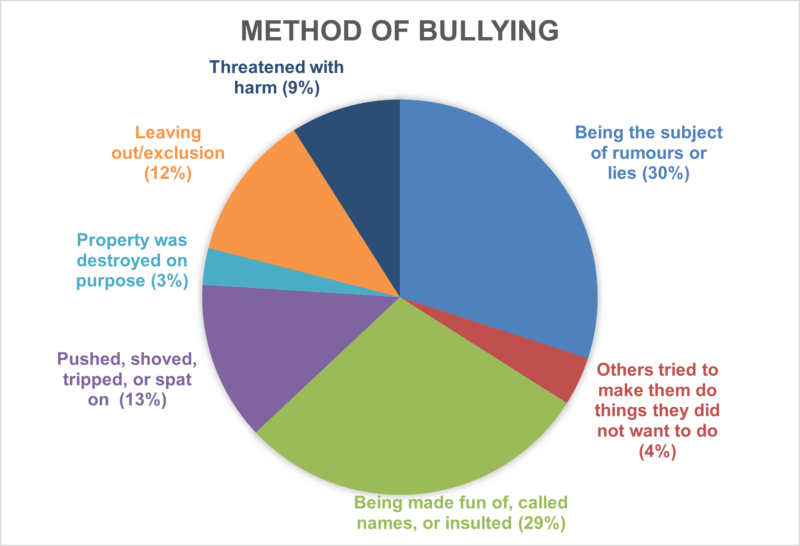
Source 13
How to prevent bullying
Parents/guardians, staff, and other caring adults have a role to play in preventing bullying. They can:
- Help children understand bullying. Talk openly about what bullying is and how to stand up to it safely. Develop the child’s understanding that is it not acceptable and where to get help.
- Keep the lines of communication open. Check in with children and listen to them often. Know their friends, ask about school, and understand their concerns.
- Encourage children to do what they love. Special activities, interests, and hobbies can boost confidence, help children make friends, and protect them from bullying behaviour.
- Model how to treat others with kindness and respect. Showing them that it is okay to ask for help, even as an adult.
Helping children to understand bullying
Children who know what bullying is, can better identify it and talk about bullying if it happens to them or others. Children need to know ways to safely stand up to bullying and how to get help.
- Encourage children to speak to a trusted adult if they are bullied or see others being bullied. The adult can give comfort, support, and advice, even if they can’t solve the problem directly.
- Talk about standing up to bullies safely. Give tips, like using humour and saying “stop” directly and confidently. Talk about what to do if those actions don’t work, like walking away.
- Talk about strategies for staying safe, such as staying near adults or groups of other children in unknown environments.
- Educate children in tolerance.
- Remind parents and guardians that they can start these conversations too. Keeping the lines of communication open, will help a child to feel safe to share information.13
| Support | Resources |
| Anti-Bullying Alliance | Top Anti-bullying tips |
| Child Line 0800 1111 | United Against Bullying Programme |
| NSPCC | November: Anti-Bullying Week Resources |
| Family Lives offers support for the whole family | Cross-Curricular Approach – Integrating Bullying Prevention into Subjects |
| Assemblies | |
| Take time to listen, take time to talk |
5. Prejudice-related incidents
1 in 4 children report experiencing online hate due to their sexual orientation, race, religion, disability or gender identity.3 It is important that all staff and volunteers have sufficient training to address racism and prejudice in every-day life. They also need to be able to tackle verbal ‘it’s just banter’ comments, such as derogatory words towards different ethnicities, genders and sexual orientation.
Improving your understanding of the variations of prejudice incidents, will ensure that you are able to provide intervention and support the target(s). Not all prejudice incidents are racial.
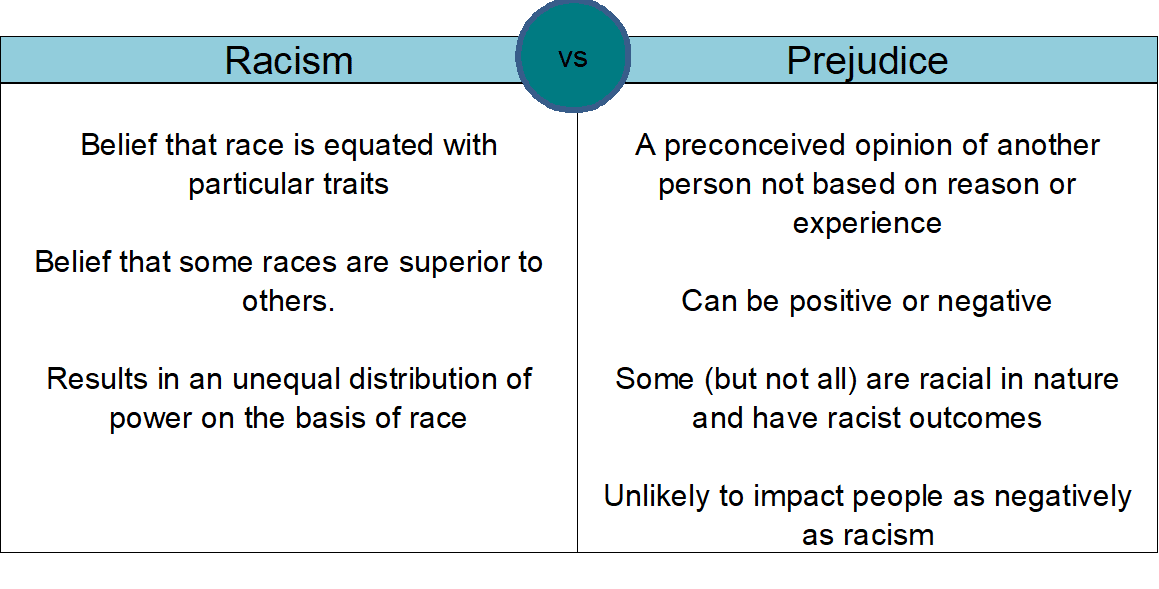
Source 14
Prejudice related incidents can include verbal assaults, offensive jokes or language, mockery and ridicule. They may be based on social stereotypes and may or may not be directed at individuals.
Stereotypes are powerful and pervade our society. Not all stereotypes cause harm but many reinforce prejudices that can result in attitudes and behaviours that lead to bullying and other forms of physical or psychological harm.
In a study carried out by Ofsted, many pupils said that they were aware that such language was unacceptable but it was seen as ‘banter’. Staff who also viewed it as banter did not challenge it, or feel they have the confidence or skills to challenge it.
When such comments occur in the classroom, playground, or other place where children gather, the staff (including volunteers) need to have the training and expertise to respond in a constructive way that helps children develop appropriate behaviour. For untrained staff, finding an appropriate response can be difficult, especially if the establishment culture fails to reinforce inclusive attitudes which value diversity. Training needs to focus on the different types of bullying (covering all diversity characteristics) that could occur and the effects they have; general and non-specific training does not equip staff with the skills they need.
Expressions of prejudice can also come from parents and guardians. Sometimes these can be aggressive and targeted directly at staff. Establishments will need to work closely with parents, guardians, and other members of the community, to reach a better understanding of the establishment’s values and the benefits of a society that challenges bullying and prejudice.
Staff who are victims of BPRIs will also need support and intervention.
Racism
Racism arises where a person is targeted because of their skin colour, ethnicity, culture, national origin or nationality. Travellers and Gypsies (e.g. Irish Travellers, Roma and Romany Gypsies) are included in the definition of race. Racism can arise without an intended target, for example, children making offensive remarks about a particular group between themselves.
| Support | Resources |
| Gate Herts – report Traveller racism and access support | Review your Equality policy by completing an audit |
| Young Minds – support parents and staff to support children | Embed anti-racism in your curriculum |
| The Red Card – access support and training for establishments | Celebrate Black History Month in October and Traveller History Month in June |
| Seek support from EMTAS |
Religion and belief
Religion and belief include major faiths such as Christianity, Islam and Judaism as well as no belief at all. Sometimes religious based incidents are reported as racist, for example incidents directed at Muslims or Sikhs of Asian origin, because the child is perceived as different not only by their religious clothing but also their skin colour or family heritage.
As with racism, religious based bullying and incidents can have similar impacts on a target’s sense of identity and belonging. 1 in 4 Muslim children experience bullying due to their religion.6
| Support | Resources |
| Young Minds – support parents and staff to support children | Encountering Faiths & Beliefs for KS2 and KS3 – The Faith & Belief Forum (faithbeliefforum.org) – A selection of resources and assemblies |
| The Red Card – access support and training for establishments |
Disability
Ableism/disability is discrimination and social prejudice against people with disabilities and/or people who are perceived to be disabled. Ableism characterizes people as defined by their disabilities and inferior to the non-disabled.
It is important that staff are aware of the changes to the Equality Act regarding the legislation around disability. Here you will find guidance on what staff need to know. Staff should also be provided with the appropriate CPD, so that they are able to manage pupils with disabilities in the classroom. For example, too often children with a diagnosis of ADHD are receiving sanctions for not being able to sit still or being fidgety in class. 36% of SEND children experience bullying due to their disability7 and some of these reports are experiences in the classroom.
Establishments should also develop a growth mindset, in order to prevent disability discrimination amongst children and staff.
| Support | Resources |
| DIAS – support for families and children | Develop tolerance in your curriculum |
| Teacher’s guide to Understanding ADHD |
Sexual orientation
A person’s sexual orientation, or sexuality, is the part of their identity that relates to who they find attractive. Although it is in the name, the attraction to other people does not have to be sexual, it could be romantic or connection based. Some people are attracted to a particular gender, or genders, some people are attracted to who the person is (their morals, values, humour, intelligence, etc.) and for some it is a combination of the two.
You may see the letters “LGBT” or (“LGBTQ+”) used to describe sexual orientation. This abbreviation stands for “lesbian, gay, bisexual, and transgender” (or “lesbian, gay, bisexual, transgender, questioning and other”). Transgender isn’t really a sexual orientation. People who are transgender are often included with lesbian and gay as a way to include people who do not feel they fit into the category of being “straight.”15
Nearly half of lesbian, gay and bisexual children experience derogatory comments in establishments. This increased to over 64% for Transgender children. 4
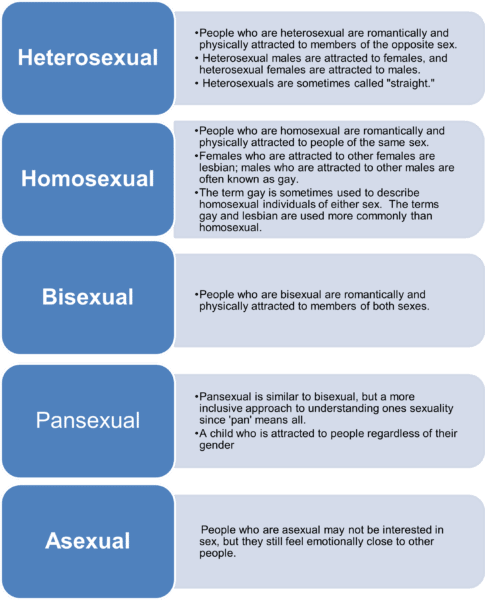
Source 15
| Support | Resources |
| EACH a freephone Helpline for children experiencing homophobic, biphobic or transphobic bullying or harassment: 0808 1000 143. It’s open Monday to Friday 10am-5pm.
| Rainbow Flag Award |
| Stop Hate UK | Have an inclusive curriculum – Primary |
| Equip your staff to tackle Sexual orientation prejudice – Ten steps | Include Sexual orientation guidance in your policies – Primary Toolkit and Secondary Toolkit |
| In colleges, champion sexual orientation diversity – Champion Awards | Celebrate LGBT+ History Month in February |
| Big Talk Education have a clear video on understanding Transgender. |
Gender identity
Gender identity refers to a person’s understanding and experience of their own gender, it is their internal sense of self. Everyone has a gender identity; for some people, it corresponds with the gender assigned at birth, and for some others, it does not. Gender identities are expansive and do not need to be confined within one collectively agreed-upon term.
A child’s appearance may not inform you or their gender identity. It is important to understand that one’s gender identity does not direct the way we are or the clothing we choose to wear.
Transgender people may have the body of one gender but feel that they are the opposite gender, like they were born into the wrong type of body. Transgender children are the highest victims of bullying.
A Female to Male (FtoM) person will have been assigned a female sex at birth yet identifies their gender as male; a Male to Female (MtoF) person will have been assigned as male at birth yet identify their gender as female.
The word transgender is sometimes used interchangeably with terms such as transsexual or gender-variant but usually has a narrower meaning and different connotations than gender variant, including non-identification with the gender assigned at birth.
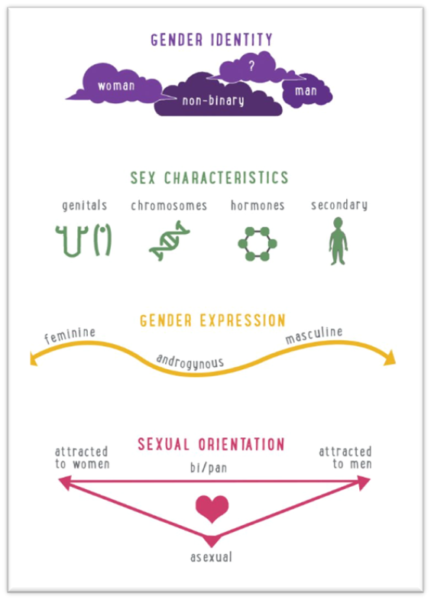
Source 17
Children who experience issues with their gender development, or are gender non-conforming, may or may not be transsexual, some will not retain their gender variance following puberty because this can be fluid.
Gender variant people may also use terms such as non-binary, genderqueer or genderfluid to identify themselves.17
Understanding gender identities is important. If a child divulges their thoughts and feelings about their gender, being equipped with the knowledge will support them to continue to feel safe. There are many resources online to support children with understanding their identity and a few a listed later.
This list of definitions of some gender identities, must be taken fluidly and is by no means an exhaustive list. A child may feel their experience of themselves falls into one category, some may experience a more than one and others may address their identity as a variation.
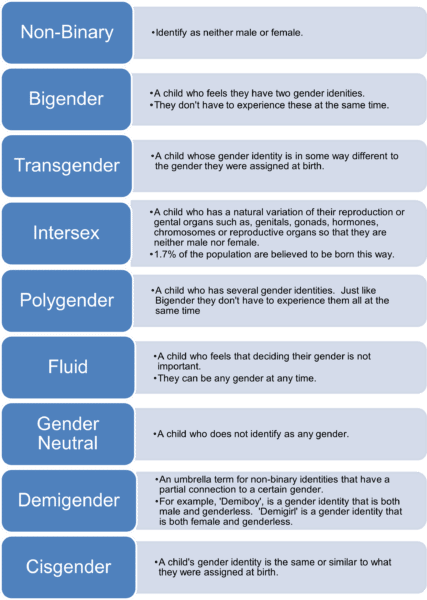
Source 17
The Human Rights Act 1998 support the rights and needs of transgender children to live their lives in their true gender. With the Equality Act 2010 further protecting them.
| Support | Resources |
| The Proud Trust – they have lots of resources and guidance to help everyone, including children understand gender identity | The Proud Trust – secondary resources – has assemblies, classroom resources and toolkits for secondary ages children. |
| Stop Hate UK | The Proud Trust – primary resources – also has various resources to deliver for primary aged children. |
| School Transgender Guidance Booklet – support staff in understanding how to improve inclusivity | Educators for Change – deliver tolerance lessons to children |
Sexism and sexual harassment
Sexism and sexual bullying affect both boys and girls, men and women. Boys may be targets as well as girls, and both sexes may be targets of others who share the same sex. However, sexism and harassment are noted more with females and a third of young females (11-21 years old) have experienced controlling or bullying behaviour from their partners.5
Sexism and sexual bullying may be characterised by name-calling, comments and overt looks about appearance, attractiveness and emerging puberty. It therefore goes beyond normal and acceptable ‘fancying’ to a level that makes an individual feel harassed.
It’s important to be aware of Misogyny, the extreme hatred and contempt for women.
There are lots of suggestions and guidance on what establishments can do to prevent and support children with sexism and sexual harassment. Providing sufficient training to staff so that they can identify signs of sexism and sexual harassment is the first step. Also having this area of education committed into your curriculum will go a long way to prevention and respect.
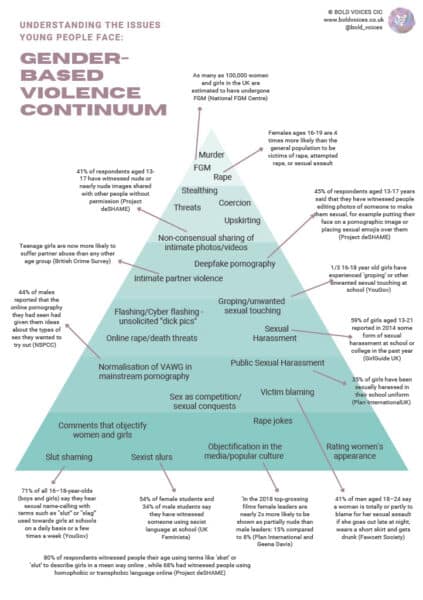
Source 18
Keeping children safe in education 2023, outlines a whole establishment approach:
Establishment’s play a crucial role in preventative education. Preventative education is most effective in the context of a whole-establishment approach that prepares children for life in modern Britain and creates a culture of zero tolerance for sexism, misogyny/misandry, and sexual violence/harassment.
The establish must have a clear set of values and standards. These will be underpinned by the establishments behaviour or relational policy and pastoral support system, as well as by a planned programme of evidence-based RSHE delivered in regularly timetabled lessons and reinforced throughout the whole curriculum. Such a programme should be fully inclusive and developed to be age and stage of development appropriate, especially when considering the needs of children with SEND and other vulnerabilities.
This program will tackle, at an age-appropriate stage, issues such as:
- healthy and respectful relationships
- boundaries and consent
- stereotyping, prejudice and equality
- body confidence and self-esteem
- how to recognise an abusive relationship, including coercive and controlling behaviour the concepts of, and laws relating to – sexual consent, sexual exploitation, abuse, grooming, coercion, harassment, rape, domestic abuse, so called ‘honour’-based violence such as forced marriage and Female Genital Mutilation (FGM), and how to access support, and
- what constitutes sexual harassment and sexual violence and why these are always unacceptable.
Children with additional needs
Children with Special Educational Needs and Disabilities (SEND) are three times more likely to be abused than their peers.13 Additional barriers can sometimes exist when recognising abuse in SEND children. These can include
- assumptions that indicators of possible abuse such as behaviour, mood and injury relate to the child’s disability without further exploration.
- the potential for children with SEND being disproportionately impacted by behaviours such as bullying and harassment, without outwardly showing any signs
- communication barriers and difficulties overcoming these barriers. Any reports of abuse involving children with SEND will therefore require close liaison with the designated safeguarding lead (or deputy) and the SENCO.
| Support | Resources |
| Responding to sexual bullying | Posters |
| Childline | Challenging Sexism Resources |
| Barnardo’s – supporting children who are victims of sexism and sexual harassment | Outside the Box – resources for Early Years up to Key Stage 5 |
6. Understanding Hate Crime and Incidents
In most crimes it is something the target has in their possession or control that motivates the assailant to commit the crime. With hate crime it is ‘who’ the target is, or ‘what’ the target appears to be that motivates the assailants to commit the crime.
A hate crime is defined as ‘Any criminal offence which is perceived by the target or any other person, to be motivated by hostility or prejudice based on a person’s
- race or perceived race
- religion or perceived religion
- sexual orientation or perceived sexual orientation
- disability or perceived disability and
- any crime motivated by hostility or prejudice against a person who is transgender or perceived to be transgender.’
A hate incident is any incident which the target, or anyone else, thinks is based on someone’s prejudice towards them because of their race, religion, sexual orientation, disability or because they are transgender. Not all hate incidents will amount to criminal offences, but it is equally important that these are reported and recorded by the Police.
Evidence of the hate element is not a requirement. You do not need to personally perceive the incident to be hate related. It would be enough if another person, a witness, or even a Police officer, thought that the incident was hate related.19
Working with the Police
Over 80% of children say they have heard online hate speech.3 We have worked closely with Devon and Cornwall Police to provide further guidance on hate crime and when establishments should report to the Police.
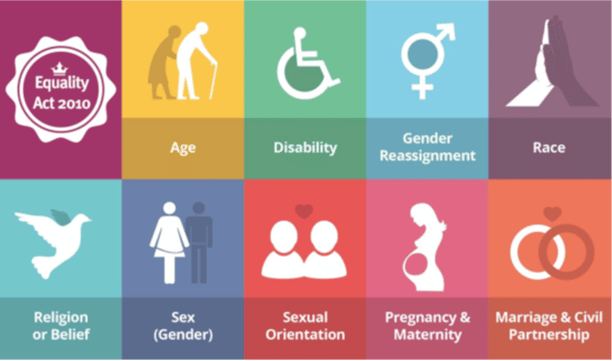
Hate incident: Behaviour has taken place which although motivated by hostility or prejudice does not amount to a criminal offence, e.g. refusing to work with another child because they are from a specific national background.
Hate crime: A criminal offence has been committed motivated by hostility or prejudice, e.g. an assault motivated by prejudice towards a person’s sexual orientation.
When to call the Police for Prejudice related hate crime and incidents:
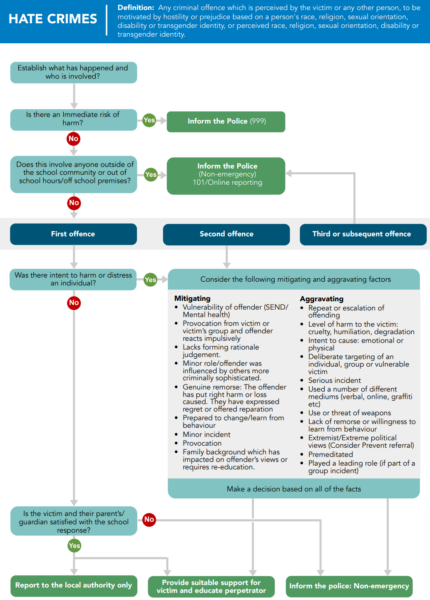
Source 20
It is not the aim of the Police to criminalise children and they would like to take this opportunity to reassure all those involved.
The process if an incident is reported is as follows:
- If the establishment contact the Police using 101 then a Storm Log will be created. The Storm log is the command-and-control log. Within this they will record the name of the reporting person, address and details of the target/assailant.
- A decision is then made to either just record decision making on the log, create an enquiry on their Unifi system or if a crime has been identified, a crime complaint is recorded on the Unifi System.
- In relation to a crime complaint, they will record the details of the reporting person (if given), the target’s details, details of witnesses and the details of the suspect, along with a summary of the offence. The crime is given a unique number and the officer in the case will then record details of the investigation on the crime report. At the end of the investigation there will be a record of the outcome, eg no further action, cautioned, charged etc next to the suspects name. The crime report and all linked information is then kept on their systems for a period of time depending on the nature of the offence/outcome in line with GDPR requirements.
- In addition to this they may also complete a VIST in order to make sure that children who may be at risk (including a suspect) have referrals to the relevant agencies in order to access support. These details are also recorded on their Unifi system and linked to the crime/enquiry to reflect the activity undertaken.
Only if a young person is convicted/cautioned for an offence would their details be recorded on the police national computer system (PNC).
Courtesy of Devon and Cornwall Police
7. Reporting BPRIs
Reporting
All incidents of bullying, prejudice and racism should be reported the local authority, and this should be made clear in your policies. This includes incidents outside of the establishment and involving staff. Reporting will ensure you have access to resources and support. If you report an incident to the police a BPRI submission should also be completed.
Please follow this link to report BPRIs.
Managing a BPRI
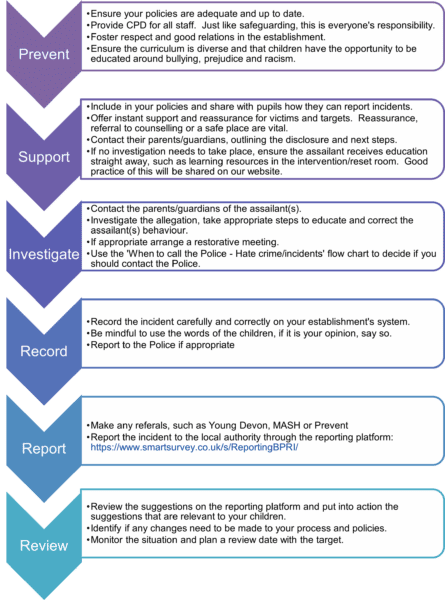
What you can expect when reporting a BPRI
Incidents to be monitored for trends and themes. We will use this information to develop and target guidance and support for schools.
Available schools support:
Understanding emotional dysregulation and how it impacts on BPRIs
We understand that when children are dysregulated they often voice words that aren’t their opinion, how they feel or their intent, but rather this is a symptom of something they need. We therefore feel it appropriate to have a ‘rule of three’, to support establishments and children in identifying when dysregulation has a part to play in BPRIs. This is particularly useful for children with additional needs and alternative provisions settings.
Symptoms of emotional dysregulations
In general, emotional dysregulation involves having emotions that are overly intense in comparison to the situation that triggered them. This can mean not being able to calm down, avoiding difficult emotions, or focusing your attention on the negative. Most children with emotional dysregulation also behave in an impulsive manner when their emotions (fear, sadness, or anger) are out of control.24
The ‘rule of three’
This only applies to children who are in a heightened dysregulated state and there is no intent or real target.
If a child is dysregulated, they have two opportunities to make the right choice in correcting their language or behaviour. If they do make this positive choice, then the incident can be recorded on the establishment’s system and further education provided. If they still are displaying BPRI behaviours a third time, then a report needs to be made to the local authority, as well as being recorded on the establishment’s system and education.
If anyone involved feels that a BPRI should be completed, or someone requests it, then the usual procedure for reporting BPRIs should be adhered to. It is also important to note that indirect targets in the vicinity may need support.
We have designed this strategy to meet the needs of children, who struggle with emotional regulation. We expect establishments to provide the correct education and restorative approach after the incident. Each establishment has the right to deploy this strategy or to not use it. If it is to be used in your establishment, it should be within your policies and shared with staff, children and parents/guardians.
8. Your establishment’s policies
Relationships, Sex Education and Health Policy
In 2019 the Relationships and Sex Education (RSE) and Health guidance was issued, as a way to instruct establishments on areas that should be taught, to improve education and a way to improve a consistent approach. Here is a brief introduction to the guidance and for further details of designing a policy and learning outcomes at each stage, please refer to the published guidance.
All establishments must have in place a written policy for Relationships Education and RSE. They must consult parents/guardians in developing and reviewing their policy and this helps to foster good relations. Establishments should ensure that the policy meets the needs of children and parents/guardians and reflects the community they serve. Your up-to-date policy must be made available to parents/guardians and others along with being published on their website.
The policy should contain information on:
The education of mandatory subjects
- define relationships education
- set out the subject content, how it is taught and who is responsible for teaching it
- describe how the subject is monitored and evaluated
- include information to clarify parents/guardians right to withdraw their child
- confirm the date by which the policy will be reviewed
The policy for secondary education should also include
- define relationships and sex education
- set out the subject content, how it is taught and who is responsible for teaching it
- describe how the subject is monitored and evaluated
- include information about a parent’s right to request that their child be excused from sex education within RSE only
- confirm the date by which the policy will be reviewed
Education for non-mandatory subjects
For primary schools that choose to teach sex education, the policy should:
- define any sex education they choose to teach other than that covered in the science curriculum
- set out the subject content, how it is taught and who is responsible for teaching it
- describe how the subject is monitored and evaluated
- include information about a parent’s right to request that their child be excused
- confirm the date by which the policy will be reviewed21
Big Talk Education have outlined a suggestion of appropriate ages to learn different areas of relationships, sex education and health. They also share case studies and resources to support establishments in supporting this area of education. From their studies children who begin to feel and identify differently do so as young as 2 years old.
| It is important to understand that all parents/guardians have the right to withdraw their children from any/all relationship and sex education discussions, for a child under the age of 16. This is outlined in the new guidance. This can be due to religious reasons, cultural (such as Travellers) or even a personal choice.
We suggest good practice would be to highlight to all parents/guardians when any such topics are planned in the curriculum and explain to them the purposes of such lessons. If a parent/guardian does wish to withdraw their child from these lessons, then this must be respected and not challenged. You can offer suggestions to support their choice, such as offering to deliver the topic 1:1 with the child, instead of in the class or having ‘girls’ and ‘boys’ separate and the same ‘gender’ delivering the topic. If the parent/guardian withdraws their child, please ensure that the child has been provided with a non-related learning activity elsewhere in the school and suggest to the parent/guardian that they could take the resources home and deliver it together. |
| Support on delivering relationships, sex education and health in establishments |
| Examples of good practice – Research commentary: teaching about sex, sexual orientation and gender reassignment – GOV.UK (www.gov.uk) |
| Q&A following the guidance |
| Secondary Toolkit – pdf, Primary Toolkit – pdf and Early Years – Getting Started Toolkit |
| Big Talk Education – resources and suggestions of what age to cover certain topics. |
Anti-Bullying Policy
It is important to have a separate anti-bullying policy to your behaviour policy. This ensures clarity for staff, children and parents/guardians. Of course, there will be links with the behaviour policy, such as consequences and fostering good relationships.
Like all policies, they are the most effective if children, staff and families are involved in the discussions. Involving children promotes their right to be involved, under article 12 of the United Nations Convention on the Rights of the Child 1989. Having a core group to discuss a new policy or to review an existing one, will provide a valuable insight to current experiences and highlight any voids within the current policy.
The Anti-bullying Alliance has 10 Key Principles that can help guide the development and reviews of anti-bullying policies:
- listen – all pupils and parents/guardians are listened to and influence strategies and approaches to prevent, report and respond to incidents of bullying.
- includes all – all children, including those with SEND, are included, valued and participate fully in all aspects.
- respects – all staff are role models to others within the establishment in how they treat others.
- challenges – all forms of discriminatory language – including disablist language – is challenged taken seriously.
- celebrates difference – difference is actively and visibly celebrated and welcome across the whole establishment.
- understands – all staff, children and parents/guardians understand what bullying is and what it isn’t.
- believes – all children, including disabled children and those with SEN, and their parents/guardians are acknowledged, believed and taken seriously when reporting incidents of bullying.
- reports bullying – all children within the establishment, their parents/guardians and staff understand how to report incidents of bullying.
- takes action – we respond quickly to all incidents of bullying. Children, including disabled children and those with SEN, participate fully in decisions made about them and help to formulate appropriate action to respond to incidents of bullying
- has clear policies – our establishment’s anti-bullying policy reflects these principles and is embedded within other policies. They are widely and actively promoted to all.22
| Support on delivering anti-bullying education |
| Anti-bullying Alliance – resources, prevention and Guidance |
| Primary Webinar/Secondary Webinar – rewriting your anti-bullying policy |
| Preventing and Tackling Bullying DfE Guidance |
Diversity or Inclusivity or Equality Policy
Whatever you decide to call this policy the aims are the same:
- Identify legislation that protects children.
- Outline the establishments responsibilities.
- Outline the establishment’s mission statement.
- Identify the establishment’s objective to prevent discrimination, inequality and disadvantage, this includes education within the curriculum and how you promote positive behaviour and foster good relationships.
- Identify the process of dealing with and reporting incidents (making it clear that all incidents will be reported to the local authority).
- Providing definitions and who is responsible for actioning and monitoring.
It is also important to note that the new Equality Duty has two parts: the “general” duty and “specific” duties.
The general duty is the overarching legal requirement for establishments and means they must consider how their policies, practices and day-to-day activities impact on children and staff. Establishments are required to have “due regard” to the need to:
- Eliminate unlawful discrimination, harassment and victimisation.
- Advance equality of opportunity.
- Foster good relations.
The two specific duties for establishments aim to assist them to meet the general duty. They are:
- To publish information to show how they are complying with the Equality Duty. This must be updated at least annually.
- To prepare and publish one or more specific and measurable equality objectives at least every four years.
| Support on improving your Diversity/Inclusivity/Equality Policy |
| The Equality Act 2010 and Schools DfE Guidance |
| Supporting Guidance |
Anti-Racism policy
This policy may be included in your Equality policy, however, establishments that have this separate are demonstrating the seriousness of racism and the importance to prevent these negative experiences for children. If it is included in another policy, this should be made clear in a subheading and throughout the policy.
In response to the barriers report, the National Education Union created a framework to guide schools through reviewing their approach. The framework includes an audit, guidance and suggestions.
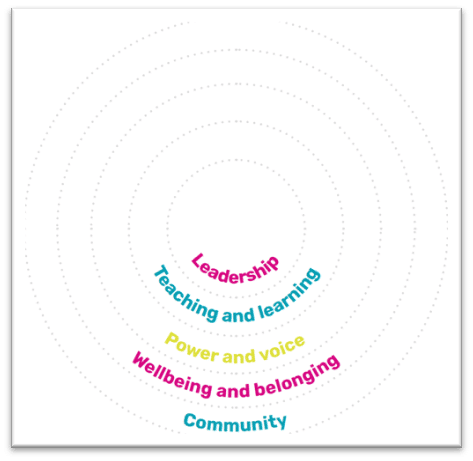
Source 23
Don’t forget that children, parents and guardians should be able to understand the content in each policy.
9. Important dates for the establishment calendar
Consider empowering your student council to be in charge of creating displays and organising celebrations.
October
| November
| December
|
February
| March
| April
|
May
| June
| July
|
Further Details: Awareness Days and Inclusion Calendar
10. One Minute Guides (OMGs)
OMG BPRI Myths and Misconceptions
You can download a copy of this from the downloads at the top
Reporting BPRIs to the local authority is an important step towards prevention and education within your establishment. Working collaboratively with the local authority helps us to direct resources, develop and offer training, whilst providing useful strategies you can use. It also demonstrates to your community that you take incidents seriously. 1 in 5 children experience bullying and 25% experience online hate due to their sexual orientation, race, religion, disability or gender identity. Children who experience bullying in any form are up to 5 times more likely to experience difficulties with their mental health. We recognise that there are often barriers to submitting a BPRI and so we would like to discuss some of your concerns in this One Minute Guide (OMG). Reporting a BPRI is the responsibility of trustees, governors and staff.
If our school/setting reports a high volume of incidents, then the local authority will judge our school/setting as ‘failing’ its children.
This is a myth; establishments that report effectively are demonstrating that they take BPR incidents seriously and have a zero-tolerance policy and approach. Additional support might be offered to your school in order to provide guidance and expertise.
If my school/setting reports a high volume of incidents, then Ofsted will arrange an emergency visit.
This is a misconception; the legislation explains that Ofsted has the expectation that establishments follow the correct procedure to prevent and manage any incident.
The incidents reported to the local authority are not directly sent to Ofsted and only if Ofsted request details or figures do we share this with them. Ofsted don’t have an identified threshold however, it is important to note that if an Ofsted complaint is received regarding any BPRI then often details of this will be looked up on the reporting system for clarity.
If I report a child to the Police, I will be criminalising them.
The Police want to work with young people to prevent incidents. Reports are carefully processed and a decision is made as to whether it should be logged as a criminal offence. Not all reports are recorded this way, but any intel is useful in supporting the Police with their work.
BPRI reports are shared with other teams and schools/settings.
As per our privacy policy, any reports are only shared with those who need to know the information in order to carry out their duties. This can be the local authority safeguarding team, the Police, Ofsted inspectors and the team who review the incidents, for example. General data and statistics will be published for Devon as a whole but no individual school or incident will be mentioned.
If we don’t report incidents to the local authority, no one will know that we have had any.
This is also a misconception. Many local authority staff work in establishments, working closely with children and families and so they hear of incidents regularly. You may find that these staff challenge establishments as to why there isn’t a record.
It is important to note, that under your equality duty, data, objectives and compliance should be published and annually.
We have to ask parents/guardians permission to report incidents.
It is important to have it very clear in your policies, that any BPR incident will be reported to the local authority. Having strategies in your behaviour, equality and anti-racism policy will further support those involved.
You do not need to have permission from the parents/guardians however you can explain the purpose and that no full name or date of birth is provided.
This is just adding another layer to our workload.
Actually by reporting incidents you are provided with suggestions to support pupils and educate assailants such as resources or training. This means that you don’t have to spend the time doing the research yourself. This support can raise awareness in your establishment which would hopefully reduce the number of incidents. Through prevention, this will reduce workload and make for a safer and happier establishment. The new online platform means you can report an incident in minutes and will get instant suggestions to help prevent future incidents.
All incidents that are reported to us are reviewed. This helps us to identify new trends and issues. We then respond to this new information by offering training, creating one-minute guides or contacting the schools/settings directly to offer intervention for the target(s) and/or the assailant(s). Our new BPRI resource provides a wealth of updated information.
Only incidents on school/setting grounds, need to be reported.
The Education and Inspections Act 2006, makes it very clear that schools/settings have a responsibility to address all incidents involving their children, including those that occur out of school/setting. All incidents that are made known to the establishment, involving their staff, children or parents/guardians, should be reported to the local authority.
We only have to report incidents that involve children.
This is a myth. Any incident involving anyone in your establishment should be reported. Even if someone from the community targets someone in your school/setting, it should be reported.
It is important in your staff policies to make it clear that incidents towards/involving staff will also be reported in the same manner. Your establishment will also have its own whistle-blowing policy.
OMG BPRI Advice for Parents and Guardians
You can download a copy of this from the downloads at the top
Has your child been a victim of bullying, prejudice or racism?
When your child reports to you an incident that has occurred, the majority of the time establishments deal with these incidents effectively.
What can a parent/guardian do:
- Reassure your child that they are loved and supported. Hear their report of the incident and if need be, write down the events. Be mindful to not lead or ‘put words’ in their report.
- If you have any concerns, the next step is to contact the establishment and report the incident, as the child may not have done so, or done so clearly enough. Provide the establishment with all the information you have and ask them for a time frame that you can expect a call back.
- Provide support to the child. Our BPRI resource 2022, has lots of suggestions. Don’t hesitate to ask the establishment what support they can provide and suggest. There are various sources for support including webinars and counselling, such as Breathe.Think.
- When the investigation, consequences and support has been completed by the establishment, feel free to enquire if they have reported the incident to the local authority. Due to GDPR, establishments will not share the details of their report to the local authority with you. You can also access lots of information from the establishments own policies. These should be displayed on their website.
- If you are still concerned, or your child needs further support, ensure this is voiced to the establishment. The principal or director will be happy to have a meeting to discuss next steps.
- If there are continued concerns, please contact the establishment and/or follow their complaints procedure.
- You should have followed your concerns with the establishments complaints procedure in full, then you are able to report the incident to the local authority for review. This is not the same as making an Ofsted complaint. Your report to the local authority will be dealt with the same as the school’s report will be.
Is your child an assailant or suspected assailant of an incident?
Establishments understand that if your child has been involved in such incidents, it can be quite a trying and unsettling time for the family. Very rarely are incidents that children report false and the establishments must take them seriously. Of course, children’s perceptions of incidents should be considered and this is where you can expect the establishment to complete a thorough investigation if needed. If the establishment believe your child is an assailant(instigator) of an incident you can expect the following:
- The establishment may withdraw your child from normal lessons and provide learning in an intervention room.
- To contact you and explain the incident and if any consequences have been decided on. They may also suggest additional interventions they will provide regarding the incident, to prevent a recurrence. The establishment will outline the next steps for your child, such as a restorative meeting or the expectation that the child apologises.
- It is a good time to ask the establishment what support is in place for your child and ask to be directed to the establishments policies on the matter. These should be available on their website.
- The establishment will complete a bullying, prejudice and racism incident log (BPRI) with the local authority. Further details of how the local authority use this is below.
- If you are still concerned, or your child needs further support, ensure this is voiced to the establishment. The principal or director will be happy to have a meeting to discuss next steps.
- If you are not satisfied with the process, you will be able to find the establishment’s complaints procedure on their website and you will be able to make a formal complaint.
What do the local authority do with the incident logs?
When we receive an incident log from a establishment or parent/guardian, we will review the incident and the actions taken in response to the incident. We aim to ensure that the response is sufficient to educate the assailant, support the target and that there are steps in place to prevent further incidents. If we need to, we will provide further advice and support.
All data is protected under GDPR and only those that require the information to perform their duties will have access. Reports are only shared to those investigating Ofsted complaints or Ofsted themselves, if they request the information. Full names are never recorded (just assailant initials), their year group and gender etc.
We also collate the data to build a Devon wide picture, which helps us to direct resources and support.
To report an incident please follow this link.
OMG Preventing, Reporting and Supporting – A brief introduction for schools and settings
Prevention
- Ensure your policies are reviewed and that children, parents/guardians and staff have been involved. Making certain that children and parents/guardians can understand them, is also key.
- Outline your equality objectives clearly.
- Have your policies accessible on your website. If you update anything in your policies, you should make staff, children and parents/guardians aware.
- Demonstrate good relationships and respect.
- Make it clear in your curriculum where you will be providing education and remember every opportunity, has an opportunity to educate. Have a cross-curricular approach by integrating bullying prevention into subjects.
- Celebrate tolerance and diversity. The BPRI Toolkit 2022, has a wealth of suggested resources.
- Provide effective CPD to staff and volunteers. Often children feel that staff don’t challenge certain comments, particularly towards gender identity, sexual orientation and Travellers. Most schools are not providing training on these areas at the moment.
- Celebrate key dates. Our BPRI resource 2022 contains useful dates for you.
Reporting
- Just like safeguarding, reporting BPRIs is everyone’s responsibility.
- Have a robust system for reporting. It is important that staff know exactly how to report and which parts to select on your school system. Data can often get ‘lost’ by incorrect recording.
- Include reporting to the local authority into your policies. All BPRIs should be reported to the local authority. They will then provide suggestions and any additional support.
- Use the online platform to report a BPRI, please follow this link.
Supporting
- It’s important to offer support to any target(s) or witness(es). Provide a quiet safe space and listen.
- Contact parents/guardians of those involved.
- Whilst the assailant is in reset/intervention/bridge ensure that they are provided with work around the incident. If they made a racist remark for example, have some worksheets ready on racism, or a task for them to create a PowerPoint on racism. This instant education, will have far more impact than just a warning, detention or exclusion.
- Provide the correct advice and support to the target(s) and witness(es). You can find useful links and phone numbers in our BPRI resource 2022. Remember that their parents/guardians may need support too.
- Always set a review date and ensure that the target(s) and witness(s) have a ‘check-in’ with a member of staff a few weeks later. If you need further support, please contact us.
- Review what needs to be done in your establishment to prevent further incidents. This could be to hold an assembly, deliver workshops or send a newsletter home to parents/guardians.
- Remember a key part to supporting your children is to understand incidents, the motivation, frequency and what is working in your establishment to prevent further incidents.
- Share good practice. The local authority is in the process of creating a ‘good practice’ web page and we would like to share your good practice.
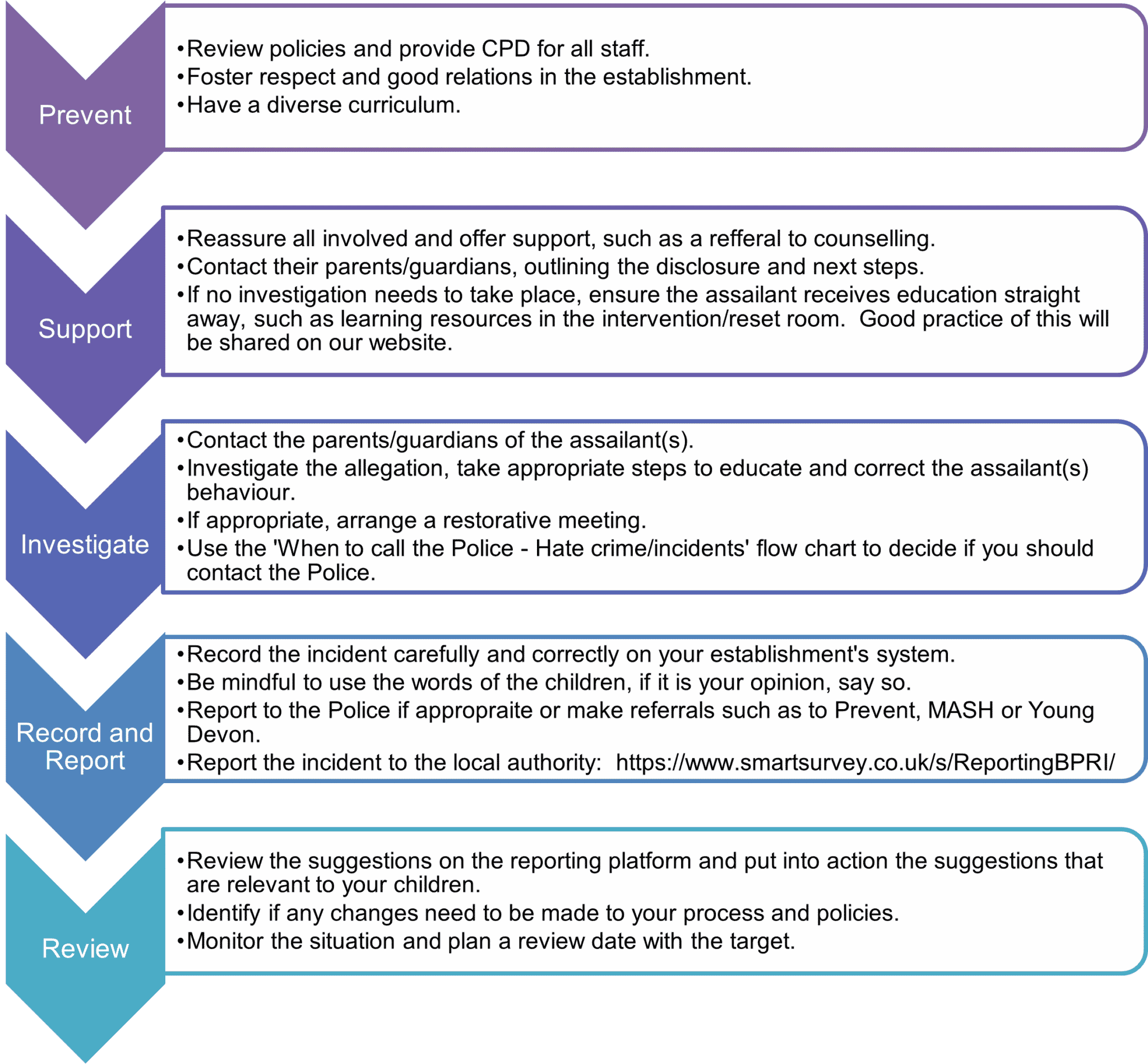
OMG Submitting a BPRI
How to submit a BPRI
You should report all BPRIs through the online platform:
What to Expect when completing a BPRI submission
- You will first be given tips to help you complete your submission.
- You can easily go back and forwards in your submission.
- If you can’t complete it straight away, you can click save. You will be sent an email with a link to return to the submission to complete.
- When you have provided details of the incident, you will be given suggestions and advice. All the links in the reporting platform will open in a new tab/window, so you will not lose your submission.
- Once submitted you can print a copy of your submission or create a log number. You will also be emailed a PDF copy of your submission. Decide as an establishment how you wish to record your submission on your own system – recording a log number is speedier.
- A log number would be the date of the incident and the initials of the assailant, e.g., 130822MB.
- You can request that the local authority contacts you for additional support. Please note, that they local authority may still contact you to follow up or provide further advice.
- You must complete all answer boxes with a small *. Any question that might be irrelevant to some circumstances can be skipped if it isn’t relevant to your incident.
- You can include more than one assailant or target in one submission. Enter each target or assailant individually – you will be provided with the option to add an additional people or children.
Checklist
Ensure you have the following details to hand when submitting your BPRI. You can copy and paste from your own system, to do this, highlight what you want to copy, then press ‘CTRL + C’ at the same time and then ‘CTRL + V’ into the answer box. You can also use the ‘tab’ key to move through the platform.
You will be asked for:
- establishment name and MAT/trust/federation of Local Authority
- your own email address and position held
- assailant(s) detail if known – initials, demographics (gender, year group/age,
- ethnicity, religion (if known), additional needs, open to CIC/CIN/CP or Early Help)
- target(s) details, if there was one – demographics (gender, year group/age, ethnicity, religion (if known), additional needs, open to CIC/CIN/CP or Early Help)
- date of incident and incident details. You will be asked to provide a description of the incident
- main foci of incident (bullying, racism, sexual orientation, gender identity, disability, religion/belief, or sexism/sexual harassment). You will have the opportunity to select additional foci later
- the establishments response to the incident – actions taken to support the assailant(s) and target(s), as well as the whole establishment response.
- identify if this constitutes as hate crime, hate incident or extremism.
- if relevant a police log number and date.
Additional tips
Have a pen and paper to hand, so that you can write down any suggestions you would like to action and any key support you want to make note of.
- Do familiarise yourself with the BPRI Resource 2022
11. References
[1] The_Annual_Bullying_Survey_2020_2_a8a474bb3f.pdf (dtl-beta-website-assets.s3.amazonaws.com)
[3] Creating a Better Internet for All (childnetsic.s3.amazonaws.com)
[4] School Report (2017) | Stonewall
[8] Bullying: Evidence from LSYPE2, wave 3 (publishing.service.gov.uk)
[9] Society needs a makeover | Body image | Plan International UK (plan-uk.org)
[11] Inspecting establishments: guide for maintained and academy establishments – GOV.UK (www.gov.uk)
Establishment inspection handbook – GOV.UK (www.gov.uk)
[12] Keeping children safe in education 2023 (publishing.service.gov.uk)
[13] Facts About Bullying | StopBullying.gov
[14] Racism vs. Prejudice: What’s the Difference? (thoughtco.com)
[15] Sexual Attraction and Orientation (for Teens) – Nemours KidsHealth
[16] Girls are missing school because of body image worries (goodhousekeeping.com)
[17] Gender Identity (T+) – The Proud Trust
[18] Bold Voices
[19] What is hate crime? | Metropolitan Police
[21] Introduction to requirements – GOV.UK (www.gov.uk)
[22] 10 Key Principles to reducing and responding to bullying – 2021.pdf (anti-bullyingalliance.org.uk)
[23] view (neu.org.uk)